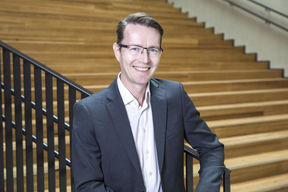Matias Palva, Professor of Brain Signal Analytics, studies the mechanisms of the human mind and brain diseases

What type of research do you do?
I study the mechanisms and structures of the human brain using non-invasive electro- (EEG) and magnetoencephalography (MEG), as well as with intra-cerebral stereo-EEG measurements from the brain. My main areas of research are how networks of brain cells, neurons, work and how different groups of neurons communicate with each other, and the roles this plays in how well people’s brains work and how abnormalities cause brain diseases such as epilepsy and depression. I also study ways to influence brain function through electrical and magnetic stimulation. Additionally, I use computer games in my research as a possible new treatment for depression.
As well as depression and epilepsy, we also study ADHD and schizophrenia. These diseases may sound different, but they all feature potential disturbances in how the brain networks at the systems level are organised to function. The Academy of Finland and Kela support my research.
My aim is to move research in the lab towards things we can use to help people with brain disorders. If patients have problems with cognitive function, the clinical research provides evidence for primary research. It is important to understand the mechanisms behind brain diseases because treatments are expensive and difficult to implement. When mechanisms are better understood, targeted treatments can be developed.
In my epilepsy research, I collaborate with the University of Genoa and the Niguarda Hospital in Milan.
How did you become a researcher?
At high school, Ismo Kalkku was my chemistry teacher. In the evenings, he allowed me to use the chemistry laboratory at the Helsingin Suomalainen Yhteiskoulu (SYK) to carry out my own experiments. I was interested in fireworks so I conducted various pyrotechnic experiments in the laboratory.
In the mid-1990s, during my third year of chemistry studies, I became enthusiastic about the emergence of functional brain imaging in Finland. Brain research as a field of science is younger than many of the more traditional fields of research, and it was the lack of available research that attracted me.
My parents have been my role models as they both study microbiology. During my research I often collaborate with my wife Satu Palva, who is a group leader at the University of Helsinki and professor of magnetoencephalography in University of Glasgow.
What have been the highlights of your career so far?
Understanding the connections between brain dynamics – how a person’s brain works – and human cognitive operations – how a person thinks – has been fascinating. Examples of this are our two scientific articles published in the Proceedings of the National Academy of Sciences of the United States of America (PNAS) in 2010 and in 2013. The 2010 article included the first large scale mapping of the brain’s functional network using the MEG method. We discovered brand new interaction networks between brain areas related to working memory, its various mechanisms and its maintenance. Satu Palva’s group has expanded this research line extensively.
The 2013 PNAS article revealed a new link between complex brain dynamics and human behaviour. The study showed that humans individual brain dynamics predict how people perform long-term behavioural tasks. People with brain activity that was well-organised in a resting state followed the same behavioural pattern during active hours. Similarly, sporadic brain activity in the resting state was seen as sporadic behaviour during active hours. This research is still ongoing and we have found brain dynamics to be a key factor in depression.
What is the most essential characteristic of a researcher?
I feel that resilience is a key ability to meet a variety of demanding life events. Additionally, Sisu, the Finnish determination, gives a person a strong will to succeed. Researchers should have a strong desire and motivation towards their field of research.
What do you expect from the future?
I want to advance Finnish brain research. I now work full-time at Aalto University, but I also continue to work at the University of Helsinki. I try to enhance the cooperation between Aalto University Department of Neuroscience and Biomedical Engineering and the University of Helsinki Neuroscience Center. Both parties have an enormous amount to offer each other. Aalto University's strength lies in neurotechnology, while the University of Helsinki has strong expertise in neurobiology and biomedicine.
Cooperation can also be established directly between different research groups when complementary strengths and shared interests are found.
- Published:
- Updated:
Read more news

Get to know us: Associate Professor Maria Sammalkorpi
Sammalkorpi received her doctorate from Helsinki University of Technology 2004. After her defence, she has worked as a researcher at the Universities of Princeton, Yale and Aalto.
Aalto computer scientists in ICML 2024
Computer scientists in ICML 2024
Getting bacteria into line
Physicists use magnetic fields to manipulate bacterial behaviour